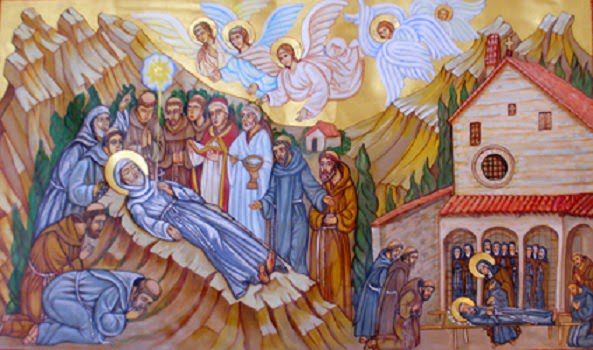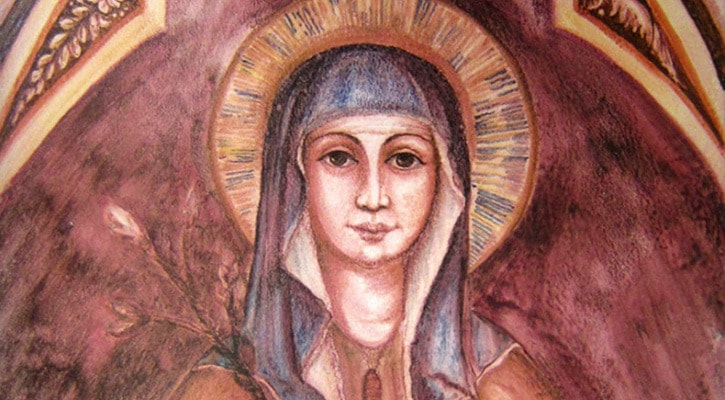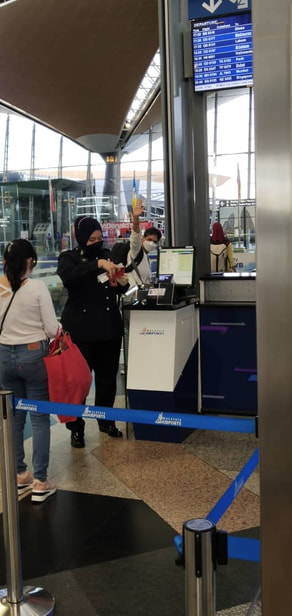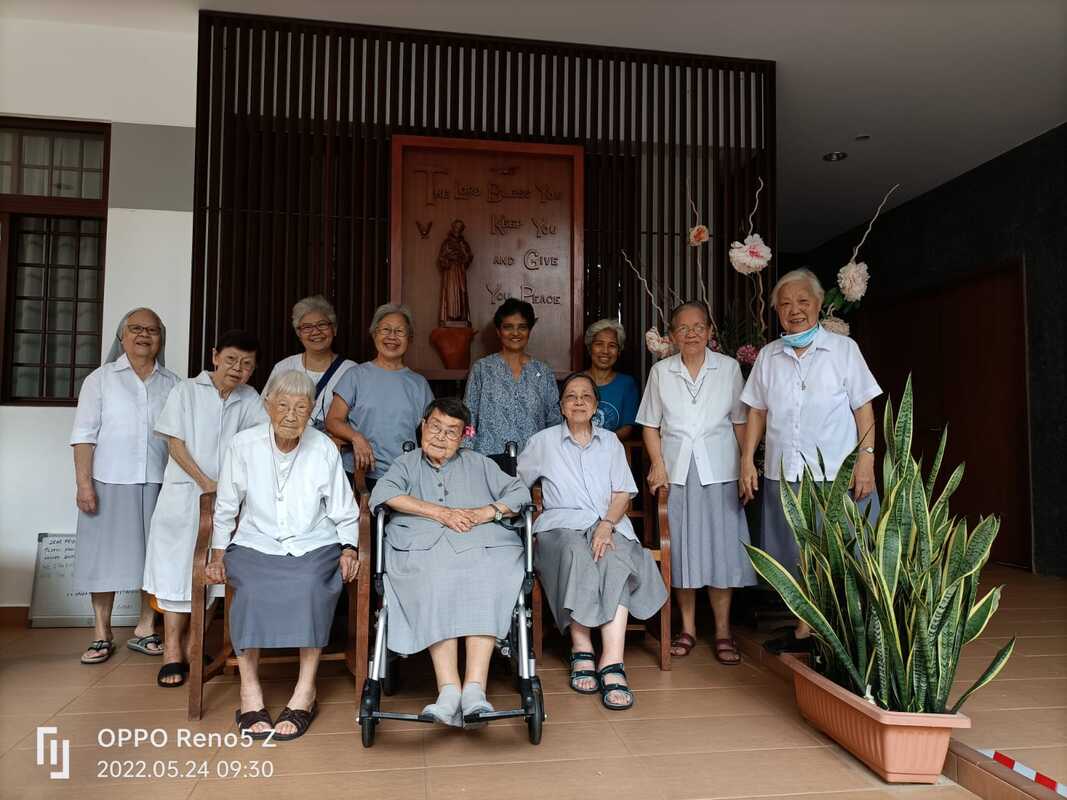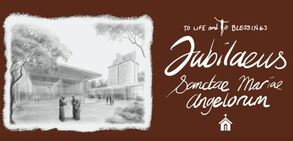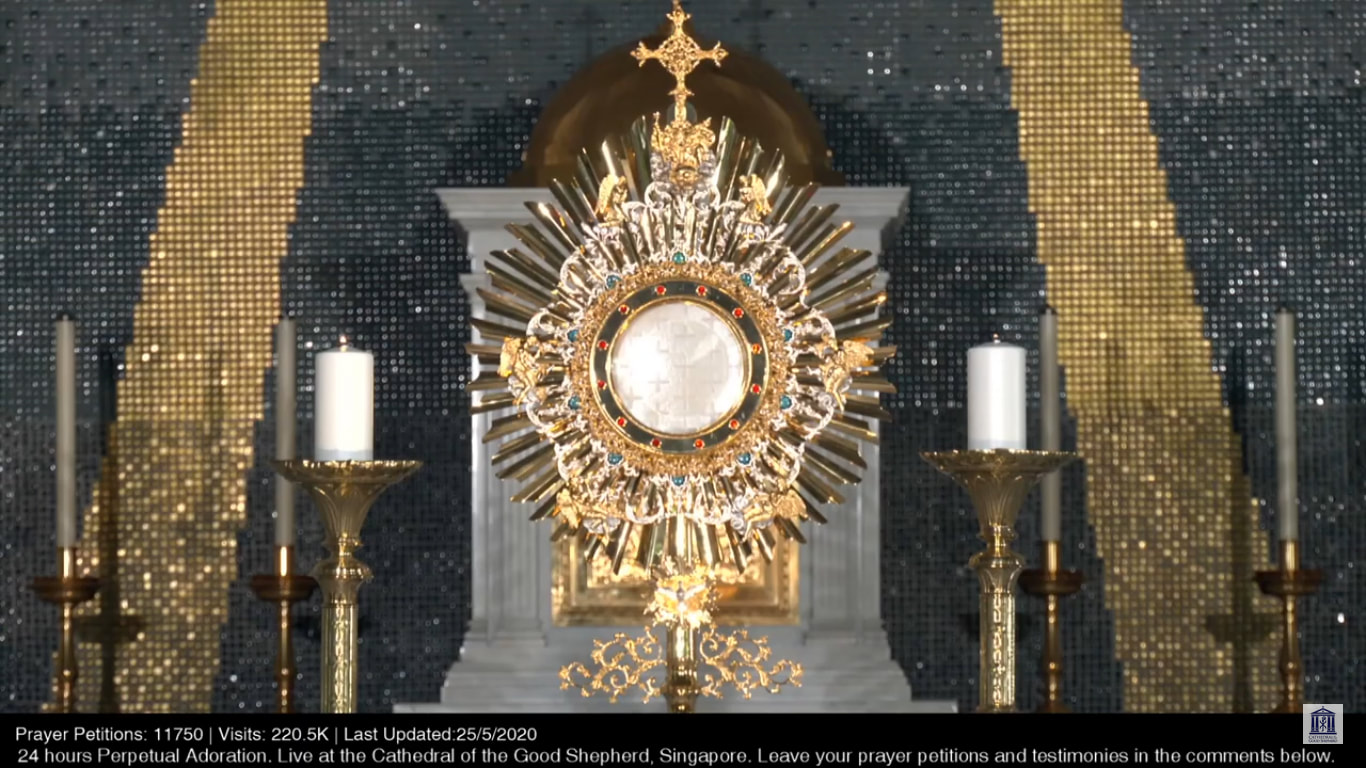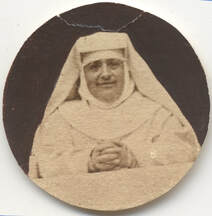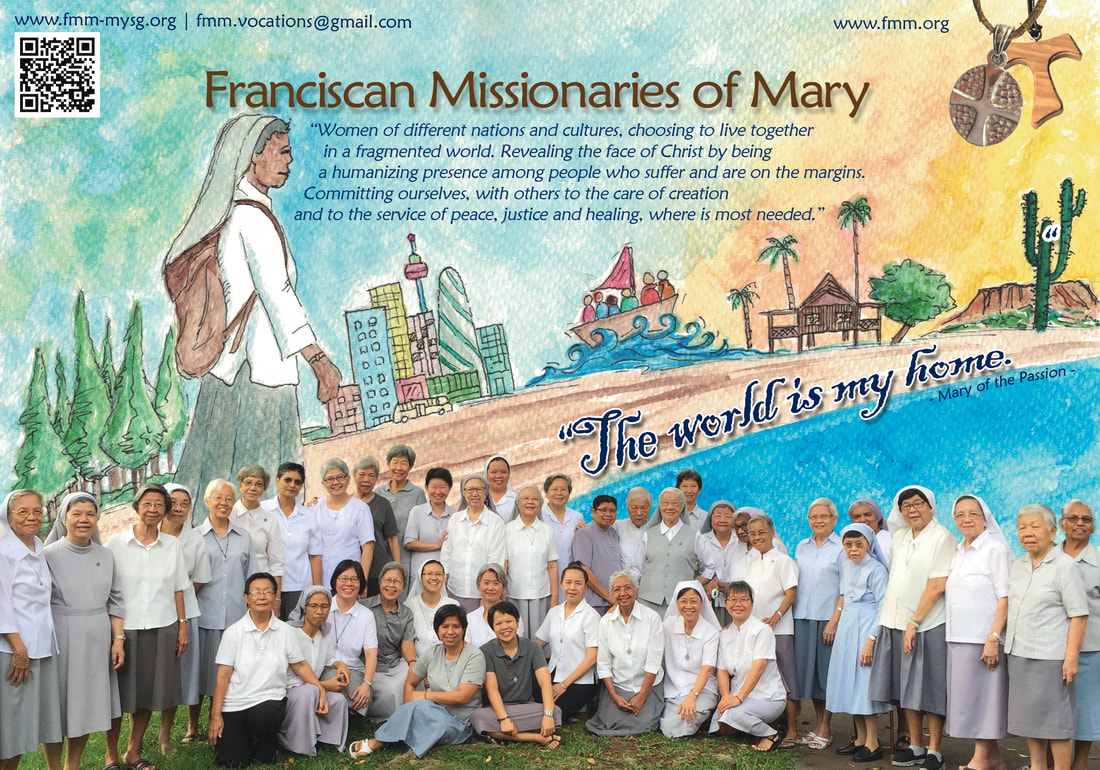Feast of the Epiphany
Feast of the Epiphany of the Lord: 6 JanuaryWe celebrate today the feast, the Solemnity of the Epiphany of the Lord, the feast of the manifestation of the Lord to the entire world. Mary of the Passion helps us to recall the significance and the great impact that this liturgical feast has for us:
“The feast of the Epiphany is the anniversary of the Foundation of our Institute. It was on that day in 1877 that Pope Pius IX deigned to bless and authorize it.
Let us consider this as a grace from heaven. This feast is that of the conversion of the Gentiles, and none could be more suitable as a date for the foundation of a missionary Institute.” (CT/1, 74)
In the Directory for the feast of the Epiphany, Mary of the Passion invites us to render thanks to Our Blessed Lord for the foundation of our Institute (especially) for having sheltered us beneath the mantle of our Father Saint Francis. Let us remember Our Most Reverend Father General’s words of advice: “That as we increase in numbers, we should decrease in our own estimation, so as to be small enough to find place beneath the Seraphic and blessed mantle.” (CT/1, 75)
Epiphany: the feast of the manifestation of Jesus to men coming from the Orient: these personify the world of people, who since the very beginning of the world have been on a journey in search of a God who can fulfil their thirst for happiness and peace.
Epiphany: the feast of the journey: in today’s liturgy, everything is in movement, everything converges towards a God, small and humble, presented to people by his young mother, who knows how to transform the grotto where the child was born into a welcoming house full of tenderness.
Epiphany: a feast which is never ended because it is that of a Church which is always in movement, in action, is always on a journey; this is the desire and the dream of Pope Francis, namely to have a Church moving along the streets of the world (“una Chiesa sempre in uscita”) announcing the Good News of love to one and all, ready to change direction like the Magi, announcing everywhere, always and to everyone, that Jesus Christ is the light and strength of every person.
Epiphany: the celebration of the birth of our FMM Institute, its development in the world along the years, the beginning of that journey of love that Mary of the Passion spread in the world, in the various continents and countries, announcing Jesus to everyone, everywhere and always.
The Magi journeyed together facing the difficulties of the journey encountered along the way. The star that had led them so far, brought them to the place where they found the new-born child in the arms of his mother.
Like the Magi, let us undertake this same journey, seeking together God’s will for the Institute on our journey of transformation, without allowing ourselves to be blocked by failures or by fear. We shall always have a star to guide us: this star is Mary Immaculate, who through the Church, will always indicate for us the right road that we are to take.
A star had announced the Redeemer of the world. For the Christian, the true star is Mary. It is she who will lead us to Jesus, and in her arms, we shall find the Emmanuel, “the God with us”. If we are faithful, we shall be her messengers, her living stars, pointing the way which leads to Jesus.
On this happy day, Mary of the Passion discloses her heartfelt wish as she traces for us the full meaning of our universal mission in the Institute. She tells us:
“How much I desire
that we all become saints worthy of our divine call:
to be living “Epiphanies”
manifesting Jesus to the world
always, everywhere, in all things.” (Rome, 6 Jan. 1895)
“The feast of the Epiphany is the anniversary of the Foundation of our Institute. It was on that day in 1877 that Pope Pius IX deigned to bless and authorize it.
Let us consider this as a grace from heaven. This feast is that of the conversion of the Gentiles, and none could be more suitable as a date for the foundation of a missionary Institute.” (CT/1, 74)
In the Directory for the feast of the Epiphany, Mary of the Passion invites us to render thanks to Our Blessed Lord for the foundation of our Institute (especially) for having sheltered us beneath the mantle of our Father Saint Francis. Let us remember Our Most Reverend Father General’s words of advice: “That as we increase in numbers, we should decrease in our own estimation, so as to be small enough to find place beneath the Seraphic and blessed mantle.” (CT/1, 75)
Epiphany: the feast of the manifestation of Jesus to men coming from the Orient: these personify the world of people, who since the very beginning of the world have been on a journey in search of a God who can fulfil their thirst for happiness and peace.
Epiphany: the feast of the journey: in today’s liturgy, everything is in movement, everything converges towards a God, small and humble, presented to people by his young mother, who knows how to transform the grotto where the child was born into a welcoming house full of tenderness.
Epiphany: a feast which is never ended because it is that of a Church which is always in movement, in action, is always on a journey; this is the desire and the dream of Pope Francis, namely to have a Church moving along the streets of the world (“una Chiesa sempre in uscita”) announcing the Good News of love to one and all, ready to change direction like the Magi, announcing everywhere, always and to everyone, that Jesus Christ is the light and strength of every person.
Epiphany: the celebration of the birth of our FMM Institute, its development in the world along the years, the beginning of that journey of love that Mary of the Passion spread in the world, in the various continents and countries, announcing Jesus to everyone, everywhere and always.
The Magi journeyed together facing the difficulties of the journey encountered along the way. The star that had led them so far, brought them to the place where they found the new-born child in the arms of his mother.
Like the Magi, let us undertake this same journey, seeking together God’s will for the Institute on our journey of transformation, without allowing ourselves to be blocked by failures or by fear. We shall always have a star to guide us: this star is Mary Immaculate, who through the Church, will always indicate for us the right road that we are to take.
A star had announced the Redeemer of the world. For the Christian, the true star is Mary. It is she who will lead us to Jesus, and in her arms, we shall find the Emmanuel, “the God with us”. If we are faithful, we shall be her messengers, her living stars, pointing the way which leads to Jesus.
On this happy day, Mary of the Passion discloses her heartfelt wish as she traces for us the full meaning of our universal mission in the Institute. She tells us:
“How much I desire
that we all become saints worthy of our divine call:
to be living “Epiphanies”
manifesting Jesus to the world
always, everywhere, in all things.” (Rome, 6 Jan. 1895)
The video clips showcases Sr. Susanna Gunawan, FMM faith journey through art. She made this as a thanksgiving to God offered at her Perpetual Profession. May her experience inspire and strenghten your own journey with God. God bless you!
Hearts on fire, feet on the move (cf. Lk 24:13-35)
Dear brothers and sisters!
For this year’s World Mission Sunday, I have chosen a theme inspired by the story of the disciples on the way to Emmaus, in the Gospel of Luke (cf. 24:13-35): “Hearts on fire, feet on the move”. Those two disciples were confused and dismayed, but their encounter with Christ in the word and in the breaking of the bread sparked in them the enthusiastic desire to set out again towards Jerusalem and proclaim that the Lord had truly risen. In the Gospel account, we perceive this change in the disciples through a few revealing images: their hearts burned within them as they heard the Scriptures explained by Jesus, their eyes were opened as they recognized him and, ultimately, their feet set out on the way. By meditating on these three images, which reflect the journey of all missionary disciples, we can renew our zeal for evangelization in today’s world.
1. Our hearts burned within us “when he explained the Scriptures to us”. In missionary activity, the word of God illumines and transforms hearts.
On the road from Jerusalem to Emmaus, the hearts of the two disciples were downcast, as shown by their dejected faces, because of the death of Jesus, in whom they had believed (cf. v. 17). Faced with the failure of the crucified Master, their hopes that he was the Messiah collapsed (cf. v. 21).
Then, “as they were talking and discussing together, Jesus himself drew near and walked with them” (v. 15). As when he first called the disciples, so now, amid their bewilderment, the Lord takes the initiative; he approaches them and walks alongside them. So too, in his great mercy, he never tires of being with us, despite all our failings, doubts, weaknesses, and the dismay and pessimism that make us become “foolish and slow of heart” (v. 25), men and women of little faith.
Today, as then, the Risen Lord remains close to his missionary disciples and walks beside them, particularly when they feel disoriented, discouraged, fearful of the mystery of iniquity that surrounds them and seeks to overwhelm them. So, “let us not allow ourselves to be robbed of hope!” (Evangelii Gaudium, 86). The Lord is greater than all our problems, above all if we encounter them in our mission of proclaiming the Gospel to the world. For in the end, this mission is his and we are nothing more than his humble co-workers, “useless servants” (cf. Lk 17:10).
I desire to express my closeness in Christ to all the men and women missionaries in the world, especially to those enduring any kind of hardship. Dear friends, the Risen Lord is always with you. He sees your generosity and the sacrifices you are making for the mission of evangelization in distant lands. Not every day of our lives is serene and unclouded, but let us never forget the words of the Lord Jesus to his friends before his Passion: “In the world you will have tribulations, but be courageous: I have conquered the world!” (Jn 16:33).
After listening to the two disciples on the road to Emmaus, the risen Jesus, “beginning with Moses and all the prophets, explained to them what was said in all the Scriptures concerning himself” (Lk 24:27). The hearts of the disciples thrilled, as they later confided to each other: “Were not our hearts burning within us while he spoke to us on the way and opened the Scriptures to us?” (v. 32). Jesus is himself the living Word, who alone can make our hearts burn within us, as he enlightens and transforms them.
In this way, we can better understand Saint Jerome’s dictum that “ignorance of the Scriptures is ignorance of Christ” (Commentary on Isaiah, Prologue). “Without the Lord to introduce us, it is impossible to understand sacred Scripture in depth; yet the opposite is equally true: without sacred Scripture, the events of Jesus’ mission and of his Church in the world remain indecipherable” (Aperuit Illis, 1). It follows that knowledge of Scripture is important for the Christian life, and even more so for the preaching of Christ and his Gospel. Otherwise, what are you passing on to others if not your own ideas and projects? A cold heart can never make other hearts burn!
So let us always be willing to let ourselves be accompanied by the Risen Lord as he explains to us the meaning of the Scriptures. May he make our hearts burn within us; may he enlighten and transform us, so that we can proclaim his mystery of salvation to the world with the power and wisdom that come from his Spirit.
2. Our eyes were “opened and recognized him” in the breaking of the bread. Jesus in the Eucharist is the source and summit of the mission.
The fact that their hearts burned for the word of God prompted the disciples of Emmaus to ask the mysterious Wayfarer to stay with them as evening drew near. When they gathered around the table, their eyes were opened and they recognized him when he broke the bread. The decisive element that opened the eyes of the disciples was the sequence of actions performed by Jesus: he took the bread, blessed it, broke it and gave it to them. Those were the usual gestures of the head of a Jewish household, but, performed by Jesus Christ with the grace of the Holy Spirit, they renewed for his two table companions the sign of the multiplication of the loaves and above all that of the Eucharist, the sacrament of the sacrifice of the cross. Yet at the very moment when they recognized Jesus in the breaking of the bread, “he vanished from their sight” (Lk 24:31). Here we can recognize an essential reality of our faith: Christ, who breaks the bread, now becomes the bread broken, shared with the disciples and consumed by them. He is seen no longer, for now he has entered the hearts of the disciples, to make them burn all the more, and this prompts them to set out immediately to share with everyone their unique experience of meeting the Risen Lord. The risen Christ, then, is both the one who breaks the bread and, at the same time, the bread itself, broken for us. It follows that every missionary disciple is called to become, like Jesus and in him, through the working of the Holy Spirit, one who breaks the bread and one who is broken bread for the world.
Here it should be remembered that breaking our material bread with the hungry in the name of Christ is already a work of Christian mission. How much more so is the breaking of the Eucharistic bread, which is Christ himself, a work of mission par excellence, since the Eucharist is the source and summit of the life and mission of the Church.
As Pope Benedict XVI pointed out: “We cannot keep to ourselves the love we celebrate in the Sacrament [of the Eucharist]. By its very nature, it asks to be communicated to everyone. What the world needs is the love of God, to encounter Christ and believe in him. For this reason the Eucharist is not only the source and summit of the life of the Church; it is also the source and summit of her mission: ‘An authentically Eucharistic Church is a missionary Church’” (Sacramentum Caritatis, 84).
In order to bear fruit we must remain united to Jesus (cf. Jn 15:4-9). This union is achieved through daily prayer, particularly in Eucharistic adoration, as we remain in silence in the presence of the Lord, who remains with us in the Blessed Sacrament. By lovingly cultivating this communion with Christ, the missionary disciple can become a mystic in action. May our hearts always yearn for the company of Jesus, echoing the ardent plea of the two disciples of Emmaus, especially in the evening hours: “Stay with us, Lord!” (cf. Lk 24:29).
3. Our feet set out on the way, with the joy of telling others about the Risen Christ. The eternal youth of a Church that is always going forth.
After their eyes were opened and they recognized Jesus “in the breaking of the bread”, the disciples “set out without delay and returned to Jerusalem” (cf. Lk 24:33). This setting out in haste, to share with others the joy of meeting the Lord, demonstrates that “the joy of the Gospel fills the heart and the whole life of those who meet Jesus. Those who allow themselves to be saved by him are freed from sin, from sadness, from inner emptiness, from isolation. With Jesus Christ, joy is always born and reborn” (Evangelii Gaudium, 1). One cannot truly encounter the risen Jesus without being set on fire with enthusiasm to tell everyone about him. Therefore, the primary and principal resource of the mission are those persons who have come to know the risen Christ in the Scriptures and in the Eucharist, who carry his fire in their heart and his light in their gaze. They can bear witness to the life that never dies, even in the most difficult of situations and in the darkest of moments.
The image of “feet setting out” reminds us once more of the perennial validity of the missio ad gentes, the mission entrusted to the Church by the risen Lord to evangelize all individuals and peoples, even to the ends of the earth. Today more than ever, our human family, wounded by so many situations of injustice, so many divisions and wars, is in need of the Good News of peace and salvation in Christ. I take this opportunity to reiterate that “everyone has the right to receive the Gospel. Christians have the duty to announce it without excluding anyone, not as one who imposes a new obligation, but as one who shares a joy, signals a beautiful horizon, offers a desirable banquet” (Evangelii Gaudium, 14). Missionary conversion remains the principal goal that we must set for ourselves as individuals and as a community, because “missionary outreach is paradigmatic for all the Church’s activity” (ibid., 15).
As the Apostle Paul confirms, the love of Christ captivates and impels us (cf. 2 Cor 5:14). This love is two-fold: the love of Christ for us, which calls forth, inspires and arouses our love for him. A love that makes the Church, in constantly setting out anew, ever young. For all her members are entrusted with the mission of proclaiming the Gospel of Christ, in the conviction that “he died for all, so that those who live should no longer live for themselves, but for him who died for them and was raised again” (v. 15). All of us can contribute to this missionary movement: with our prayers and activities, with material offerings and the offering of our sufferings, and with our personal witness. The Pontifical Mission Societies are the privileged means of fostering this missionary cooperation on both the spiritual and material levels. For this reason, the collection taken on World Mission Sunday is devoted to the Pontifical Society for the Propagation of the Faith.
The urgency of the Church’s missionary activity naturally calls for an ever closer missionary cooperation on the part of all her members and at every level. This is an essential goal of the synodal journey that the Church has undertaken, guided by the key words: communion, participation, mission. This journey is certainly not a turning of the Church in upon herself; nor is it a referendum about what we ought to believe and practice, nor a matter of human preferences. Rather, it is a process of setting out on the way and, like the disciples of Emmaus, listening to the risen Lord. For he always comes among us to explain the meaning of the Scriptures and to break bread for us, so that we can, by the power of the Holy Spirit, carry out his mission in the world.
Just as the two disciples of Emmaus told the others what had taken place along the way (cf. Lk 24:35), so too our proclamation will be a joyful telling of Christ the Lord, his life, his passion, his death and resurrection, and the wonders that his love has accomplished in our lives.
So let us set out once more, illumined by our encounter with the risen Lord and prompted by his Spirit. Let us set out again with burning hearts, with our eyes open and our feet in motion. Let us set out to make other hearts burn with the word of God, to open the eyes of others to Jesus in the Eucharist, and to invite everyone to walk together on the path of peace and salvation that God, in Christ, has bestowed upon all humanity.
Our Lady of the Way, Mother of Christ’s missionary disciples and Queen of Missions, pray for us!
Pope Francis.
For this year’s World Mission Sunday, I have chosen a theme inspired by the story of the disciples on the way to Emmaus, in the Gospel of Luke (cf. 24:13-35): “Hearts on fire, feet on the move”. Those two disciples were confused and dismayed, but their encounter with Christ in the word and in the breaking of the bread sparked in them the enthusiastic desire to set out again towards Jerusalem and proclaim that the Lord had truly risen. In the Gospel account, we perceive this change in the disciples through a few revealing images: their hearts burned within them as they heard the Scriptures explained by Jesus, their eyes were opened as they recognized him and, ultimately, their feet set out on the way. By meditating on these three images, which reflect the journey of all missionary disciples, we can renew our zeal for evangelization in today’s world.
1. Our hearts burned within us “when he explained the Scriptures to us”. In missionary activity, the word of God illumines and transforms hearts.
On the road from Jerusalem to Emmaus, the hearts of the two disciples were downcast, as shown by their dejected faces, because of the death of Jesus, in whom they had believed (cf. v. 17). Faced with the failure of the crucified Master, their hopes that he was the Messiah collapsed (cf. v. 21).
Then, “as they were talking and discussing together, Jesus himself drew near and walked with them” (v. 15). As when he first called the disciples, so now, amid their bewilderment, the Lord takes the initiative; he approaches them and walks alongside them. So too, in his great mercy, he never tires of being with us, despite all our failings, doubts, weaknesses, and the dismay and pessimism that make us become “foolish and slow of heart” (v. 25), men and women of little faith.
Today, as then, the Risen Lord remains close to his missionary disciples and walks beside them, particularly when they feel disoriented, discouraged, fearful of the mystery of iniquity that surrounds them and seeks to overwhelm them. So, “let us not allow ourselves to be robbed of hope!” (Evangelii Gaudium, 86). The Lord is greater than all our problems, above all if we encounter them in our mission of proclaiming the Gospel to the world. For in the end, this mission is his and we are nothing more than his humble co-workers, “useless servants” (cf. Lk 17:10).
I desire to express my closeness in Christ to all the men and women missionaries in the world, especially to those enduring any kind of hardship. Dear friends, the Risen Lord is always with you. He sees your generosity and the sacrifices you are making for the mission of evangelization in distant lands. Not every day of our lives is serene and unclouded, but let us never forget the words of the Lord Jesus to his friends before his Passion: “In the world you will have tribulations, but be courageous: I have conquered the world!” (Jn 16:33).
After listening to the two disciples on the road to Emmaus, the risen Jesus, “beginning with Moses and all the prophets, explained to them what was said in all the Scriptures concerning himself” (Lk 24:27). The hearts of the disciples thrilled, as they later confided to each other: “Were not our hearts burning within us while he spoke to us on the way and opened the Scriptures to us?” (v. 32). Jesus is himself the living Word, who alone can make our hearts burn within us, as he enlightens and transforms them.
In this way, we can better understand Saint Jerome’s dictum that “ignorance of the Scriptures is ignorance of Christ” (Commentary on Isaiah, Prologue). “Without the Lord to introduce us, it is impossible to understand sacred Scripture in depth; yet the opposite is equally true: without sacred Scripture, the events of Jesus’ mission and of his Church in the world remain indecipherable” (Aperuit Illis, 1). It follows that knowledge of Scripture is important for the Christian life, and even more so for the preaching of Christ and his Gospel. Otherwise, what are you passing on to others if not your own ideas and projects? A cold heart can never make other hearts burn!
So let us always be willing to let ourselves be accompanied by the Risen Lord as he explains to us the meaning of the Scriptures. May he make our hearts burn within us; may he enlighten and transform us, so that we can proclaim his mystery of salvation to the world with the power and wisdom that come from his Spirit.
2. Our eyes were “opened and recognized him” in the breaking of the bread. Jesus in the Eucharist is the source and summit of the mission.
The fact that their hearts burned for the word of God prompted the disciples of Emmaus to ask the mysterious Wayfarer to stay with them as evening drew near. When they gathered around the table, their eyes were opened and they recognized him when he broke the bread. The decisive element that opened the eyes of the disciples was the sequence of actions performed by Jesus: he took the bread, blessed it, broke it and gave it to them. Those were the usual gestures of the head of a Jewish household, but, performed by Jesus Christ with the grace of the Holy Spirit, they renewed for his two table companions the sign of the multiplication of the loaves and above all that of the Eucharist, the sacrament of the sacrifice of the cross. Yet at the very moment when they recognized Jesus in the breaking of the bread, “he vanished from their sight” (Lk 24:31). Here we can recognize an essential reality of our faith: Christ, who breaks the bread, now becomes the bread broken, shared with the disciples and consumed by them. He is seen no longer, for now he has entered the hearts of the disciples, to make them burn all the more, and this prompts them to set out immediately to share with everyone their unique experience of meeting the Risen Lord. The risen Christ, then, is both the one who breaks the bread and, at the same time, the bread itself, broken for us. It follows that every missionary disciple is called to become, like Jesus and in him, through the working of the Holy Spirit, one who breaks the bread and one who is broken bread for the world.
Here it should be remembered that breaking our material bread with the hungry in the name of Christ is already a work of Christian mission. How much more so is the breaking of the Eucharistic bread, which is Christ himself, a work of mission par excellence, since the Eucharist is the source and summit of the life and mission of the Church.
As Pope Benedict XVI pointed out: “We cannot keep to ourselves the love we celebrate in the Sacrament [of the Eucharist]. By its very nature, it asks to be communicated to everyone. What the world needs is the love of God, to encounter Christ and believe in him. For this reason the Eucharist is not only the source and summit of the life of the Church; it is also the source and summit of her mission: ‘An authentically Eucharistic Church is a missionary Church’” (Sacramentum Caritatis, 84).
In order to bear fruit we must remain united to Jesus (cf. Jn 15:4-9). This union is achieved through daily prayer, particularly in Eucharistic adoration, as we remain in silence in the presence of the Lord, who remains with us in the Blessed Sacrament. By lovingly cultivating this communion with Christ, the missionary disciple can become a mystic in action. May our hearts always yearn for the company of Jesus, echoing the ardent plea of the two disciples of Emmaus, especially in the evening hours: “Stay with us, Lord!” (cf. Lk 24:29).
3. Our feet set out on the way, with the joy of telling others about the Risen Christ. The eternal youth of a Church that is always going forth.
After their eyes were opened and they recognized Jesus “in the breaking of the bread”, the disciples “set out without delay and returned to Jerusalem” (cf. Lk 24:33). This setting out in haste, to share with others the joy of meeting the Lord, demonstrates that “the joy of the Gospel fills the heart and the whole life of those who meet Jesus. Those who allow themselves to be saved by him are freed from sin, from sadness, from inner emptiness, from isolation. With Jesus Christ, joy is always born and reborn” (Evangelii Gaudium, 1). One cannot truly encounter the risen Jesus without being set on fire with enthusiasm to tell everyone about him. Therefore, the primary and principal resource of the mission are those persons who have come to know the risen Christ in the Scriptures and in the Eucharist, who carry his fire in their heart and his light in their gaze. They can bear witness to the life that never dies, even in the most difficult of situations and in the darkest of moments.
The image of “feet setting out” reminds us once more of the perennial validity of the missio ad gentes, the mission entrusted to the Church by the risen Lord to evangelize all individuals and peoples, even to the ends of the earth. Today more than ever, our human family, wounded by so many situations of injustice, so many divisions and wars, is in need of the Good News of peace and salvation in Christ. I take this opportunity to reiterate that “everyone has the right to receive the Gospel. Christians have the duty to announce it without excluding anyone, not as one who imposes a new obligation, but as one who shares a joy, signals a beautiful horizon, offers a desirable banquet” (Evangelii Gaudium, 14). Missionary conversion remains the principal goal that we must set for ourselves as individuals and as a community, because “missionary outreach is paradigmatic for all the Church’s activity” (ibid., 15).
As the Apostle Paul confirms, the love of Christ captivates and impels us (cf. 2 Cor 5:14). This love is two-fold: the love of Christ for us, which calls forth, inspires and arouses our love for him. A love that makes the Church, in constantly setting out anew, ever young. For all her members are entrusted with the mission of proclaiming the Gospel of Christ, in the conviction that “he died for all, so that those who live should no longer live for themselves, but for him who died for them and was raised again” (v. 15). All of us can contribute to this missionary movement: with our prayers and activities, with material offerings and the offering of our sufferings, and with our personal witness. The Pontifical Mission Societies are the privileged means of fostering this missionary cooperation on both the spiritual and material levels. For this reason, the collection taken on World Mission Sunday is devoted to the Pontifical Society for the Propagation of the Faith.
The urgency of the Church’s missionary activity naturally calls for an ever closer missionary cooperation on the part of all her members and at every level. This is an essential goal of the synodal journey that the Church has undertaken, guided by the key words: communion, participation, mission. This journey is certainly not a turning of the Church in upon herself; nor is it a referendum about what we ought to believe and practice, nor a matter of human preferences. Rather, it is a process of setting out on the way and, like the disciples of Emmaus, listening to the risen Lord. For he always comes among us to explain the meaning of the Scriptures and to break bread for us, so that we can, by the power of the Holy Spirit, carry out his mission in the world.
Just as the two disciples of Emmaus told the others what had taken place along the way (cf. Lk 24:35), so too our proclamation will be a joyful telling of Christ the Lord, his life, his passion, his death and resurrection, and the wonders that his love has accomplished in our lives.
So let us set out once more, illumined by our encounter with the risen Lord and prompted by his Spirit. Let us set out again with burning hearts, with our eyes open and our feet in motion. Let us set out to make other hearts burn with the word of God, to open the eyes of others to Jesus in the Eucharist, and to invite everyone to walk together on the path of peace and salvation that God, in Christ, has bestowed upon all humanity.
Our Lady of the Way, Mother of Christ’s missionary disciples and Queen of Missions, pray for us!
Pope Francis.
Transitus of St Francis of Assisi
Each year on the evening of October 3rd the Franciscan family throughout the world pauses to celebrate the solemnity of our Holy Father Francis’s Transitus, passing over from this life to the next. In his famous Canticle of the Creatures, the saint from Assisi wrote “Praised be You, my Lord, through our Sister Bodily Death, from whom no one living can escape.” That line, written near Francis’s own embrace of Sister Bodily Death, reflects the importance and natural character of death in the life of all creation. Francis was not afraid of what would come at the end of his earthly life, choosing instead to recognize in that experience, not an end, but a transition from one way of living to another. Br. Thomas of Celano recorded an account of that transition, that transitus:
St. Francis spent the last few days before his death in praising the Lord and teaching his companions whom he loved so much to praise Christ with him. He himself, in as far as he was able, broke out with the Psalm: I cry to the Lord with my voice; to the Lord I make loud supplication. He likewise invited all creatures to praise God and, with the words he had composed earlier, he exhorted them to love God. Even death itself, considered by all to be so terrible and hateful, was exhorted to give praise, while he himself, going joyfully to meet it, invited it to make its abode with him. “Welcome,” he said, “my sister death.” (Celano, Second Life.)
When the hour of his death approached, Francis asked that all of the brothers living with him be called to his death bed and softening his departure with consoling words, he encouraged them with fatherly affection to love God. He spoke of patience and poverty and of being faithful to the Holy Roman Church, giving precedence to the Holy Gospels before all else. He then stretched his hands over the brothers in the form of a cross, a symbol that he loved so much, and gave his blessings to all followers, both present and absent, in the power and in the name of the Crucified. (St. Bonaventure, Major Life.)
Every year on the third evening of October, Franciscans ritually remember the passing of Francis of Assisi from this life into God as a reminder to renew our own commitment to follow Christ in the way of the poor man of Assisi. A key part of the celebration is to read and reflect upon the Gospel passage the Francis asked his brothers to read aloud, gathered at his death bed. The brothers read the Gospel passage from the Mass of the Last Supper, Holy Thursday. This reading from the Gospel according to John (John 13:1-17), where Jesus washes the feet of his disciples, provided a glimpse into the Gospel Life that the little, poor man from Assisi sought to live, and which we his spiritual heirs have inherited. At the heart of the reading stands the example of so-called servant leadership modeled by Jesus Christ Himself.
St. Francis spent the last few days before his death in praising the Lord and teaching his companions whom he loved so much to praise Christ with him. He himself, in as far as he was able, broke out with the Psalm: I cry to the Lord with my voice; to the Lord I make loud supplication. He likewise invited all creatures to praise God and, with the words he had composed earlier, he exhorted them to love God. Even death itself, considered by all to be so terrible and hateful, was exhorted to give praise, while he himself, going joyfully to meet it, invited it to make its abode with him. “Welcome,” he said, “my sister death.” (Celano, Second Life.)
When the hour of his death approached, Francis asked that all of the brothers living with him be called to his death bed and softening his departure with consoling words, he encouraged them with fatherly affection to love God. He spoke of patience and poverty and of being faithful to the Holy Roman Church, giving precedence to the Holy Gospels before all else. He then stretched his hands over the brothers in the form of a cross, a symbol that he loved so much, and gave his blessings to all followers, both present and absent, in the power and in the name of the Crucified. (St. Bonaventure, Major Life.)
Every year on the third evening of October, Franciscans ritually remember the passing of Francis of Assisi from this life into God as a reminder to renew our own commitment to follow Christ in the way of the poor man of Assisi. A key part of the celebration is to read and reflect upon the Gospel passage the Francis asked his brothers to read aloud, gathered at his death bed. The brothers read the Gospel passage from the Mass of the Last Supper, Holy Thursday. This reading from the Gospel according to John (John 13:1-17), where Jesus washes the feet of his disciples, provided a glimpse into the Gospel Life that the little, poor man from Assisi sought to live, and which we his spiritual heirs have inherited. At the heart of the reading stands the example of so-called servant leadership modeled by Jesus Christ Himself.
Procession of the Blessed Sacrament at Bafoussam, Kouoptamo, Cameroon.
Feast of St Clare - 11th August...
At 18, Clare escaped from her father’s home one night, was met on the road by friars carrying torches, and in the poor little chapel called the Portiuncula received a rough woolen habit, exchanged her jeweled belt for a common rope with knots in it, and sacrificed her long tresses to Francis’ scissors. He placed her in a Benedictine convent, which her father and uncles immediately stormed in rage. Clare clung to the altar of the church, threw aside her veil to show her cropped hair, and remained adamant.
Sixteen days later her sister Agnes joined her. Others came. They lived a simple life of great poverty, austerity, and complete seclusion from the world, according to a Rule which Francis gave them as a Second Order. At age 21, Francis obliged Clare under obedience to accept the office of abbess, one she exercised until her death.
The Poor Ladies went barefoot, slept on the ground, ate no meat, and observed almost complete silence. Later Clare, like Francis, persuaded her sisters to moderate this rigor: “Our bodies are not made of brass.” The greatest emphasis, of course, was on gospel poverty. They possessed no property, even in common, subsisting on daily contributions. When even the pope tried to persuade Clare to mitigate this practice, she showed her characteristic firmness: “I need to be absolved from my sins, but I do not wish to be absolved from the obligation of following Jesus Christ.”
Contemporary accounts glow with admiration of Clare’s life in the convent of San Damiano in Assisi. She served the sick and washed the feet of the begging nuns. She came from prayer, it was said, with her face so shining it dazzled those about her. She suffered serious illness for the last 27 years of her life. Her influence was such that popes, cardinals, and bishops often came to consult her—Clare herself never left the walls of San Damiano.
Francis always remained her great friend and inspiration. Clare was always obedient to his will and to the great ideal of gospel life which he was making real. A well-known story concerns her prayer and trust. Clare had the Blessed Sacrament placed on the walls of the convent when it faced attack by invading Saracens. “Does it please you, O God, to deliver into the hands of these beasts the defenseless children I have nourished with your love? I beseech you, dear Lord, protect these whom I am now unable to protect.” To her sisters she said, “Don’t be afraid. Trust in Jesus.” The Saracens fled.
Sixteen days later her sister Agnes joined her. Others came. They lived a simple life of great poverty, austerity, and complete seclusion from the world, according to a Rule which Francis gave them as a Second Order. At age 21, Francis obliged Clare under obedience to accept the office of abbess, one she exercised until her death.
The Poor Ladies went barefoot, slept on the ground, ate no meat, and observed almost complete silence. Later Clare, like Francis, persuaded her sisters to moderate this rigor: “Our bodies are not made of brass.” The greatest emphasis, of course, was on gospel poverty. They possessed no property, even in common, subsisting on daily contributions. When even the pope tried to persuade Clare to mitigate this practice, she showed her characteristic firmness: “I need to be absolved from my sins, but I do not wish to be absolved from the obligation of following Jesus Christ.”
Contemporary accounts glow with admiration of Clare’s life in the convent of San Damiano in Assisi. She served the sick and washed the feet of the begging nuns. She came from prayer, it was said, with her face so shining it dazzled those about her. She suffered serious illness for the last 27 years of her life. Her influence was such that popes, cardinals, and bishops often came to consult her—Clare herself never left the walls of San Damiano.
Francis always remained her great friend and inspiration. Clare was always obedient to his will and to the great ideal of gospel life which he was making real. A well-known story concerns her prayer and trust. Clare had the Blessed Sacrament placed on the walls of the convent when it faced attack by invading Saracens. “Does it please you, O God, to deliver into the hands of these beasts the defenseless children I have nourished with your love? I beseech you, dear Lord, protect these whom I am now unable to protect.” To her sisters she said, “Don’t be afraid. Trust in Jesus.” The Saracens fled.
Click to set custom HTML
Chapter 2023........Deo Gratias! Lead us, Lord
FMM in KB celebrates 60 years presence in Kota Bharu
Standing on the shoulders of the FMM giants who blazed the trail before us, we proudly
celebrated on May 8th 2022, the Diamond Jubilee of continued FMM presence from May 1st
1962 in this remotest State of Malaysia, among the 90% Muslim population.
A committee of parishioners and Sisters Enid Lopez and Mary Anne Fletcher prepared for the
celebration: The Mass and slides of FMM history/ministries down the years; the decorations
so well done by a university student; the ordering of the packed lunch menu; audio-visual
setups to enjoy the occasion; the physical preparation of the Church. How much the laity
were with us was seen in the quiet practice of the altar servers; the practice of the Choir
members with Sr. Angeline Poh; the humble preparation of the tables and tableware by one of
the Basic Ecclesial Community; the gorgeous flower decorations of roses; Our chairperson
who quietly took our plans for a simple cake to another level, by contacting the owner of a
bakery who donated a beautifully decorated 3 kilo cake. Later, on invitation to our convent,
he shared how much he had been touched by the kindness of especially two Sisters to him, a
poor boy needing accommodation, and finding more care than he imagined, and gave him
values to this day
The Mass was solemnly celebrated as it was also the 5th Sunday of Easter. We FMM were
introduced as “Lamps burning our lives out before the Eucharist. '' The Church was fairly full
with people wanting to share our joy. Unfortunately, the slides could be shown only the next
week. It touched many people while reviving memories of associations with the Sisters. The
recreation was enlivened by Sr. Enid’s adaptation of “Happy Wanderer”, It appreciated
individuals and families who had specially helped the Sisters in varied ways. Spontaneous
clapping of hands and waving to the mood of the song and other music kept up the spirit of
joy and oneness of the people with us. They even started a line dance called “Jerusalema
Dance”! Many stayed on for fellowship and karaoke singing.
The next week, the updated slides were shown in the Church, accompanied by a nostalgic
commentary by Sr. Enid, who had researched the history. It depicted the early humble
beginnings by Sisters of different nationalities and languages, and the tremendous
groundwork laid by the pioneers. By going to live and work among the Muslims, the Srs
dared what no other religious congregation at that time would do: as our Constitutions says:
‘to the most dangerous remotest places where Christ is not yet known”. To today, people
years later will tell us how they experienced Christ’s love though the love of the Sisters, in
the deep relationship of friendship and concern in so many situations. Even the former
pre-schoolers say this; so do those who were accompanied in their faith formation in Chinese,
English and Bahasa. Lay persons will accompany Sisters to do marketing; to collaborate
teaching sewing classes; in the camaraderie and picnic atmosphere after Mass. All bound
together in love. The Sisters’ outreach to families in the outstations, often staying overnight
with them after Mass and catechesis; the many poor boarders who lived in the hostel needingaccommodation as well as professional and university students who later stayed, all speak of
being cared for and accompanied.
Perhaps the words of the song, “You raised me up’’ best depict the peoples’ feelings when
they think of the Sisters:
“You raise me up, so I can stand on mountains,
You raise me up to walk on stormy seas.
I am strong when I am on your shoulders,
You raised me up to more than I can be”
Thanks be to God who accomplishes things through us, of which we never thought we could
do!
Mary Anne Fletcher, fmm
.
celebrated on May 8th 2022, the Diamond Jubilee of continued FMM presence from May 1st
1962 in this remotest State of Malaysia, among the 90% Muslim population.
A committee of parishioners and Sisters Enid Lopez and Mary Anne Fletcher prepared for the
celebration: The Mass and slides of FMM history/ministries down the years; the decorations
so well done by a university student; the ordering of the packed lunch menu; audio-visual
setups to enjoy the occasion; the physical preparation of the Church. How much the laity
were with us was seen in the quiet practice of the altar servers; the practice of the Choir
members with Sr. Angeline Poh; the humble preparation of the tables and tableware by one of
the Basic Ecclesial Community; the gorgeous flower decorations of roses; Our chairperson
who quietly took our plans for a simple cake to another level, by contacting the owner of a
bakery who donated a beautifully decorated 3 kilo cake. Later, on invitation to our convent,
he shared how much he had been touched by the kindness of especially two Sisters to him, a
poor boy needing accommodation, and finding more care than he imagined, and gave him
values to this day
The Mass was solemnly celebrated as it was also the 5th Sunday of Easter. We FMM were
introduced as “Lamps burning our lives out before the Eucharist. '' The Church was fairly full
with people wanting to share our joy. Unfortunately, the slides could be shown only the next
week. It touched many people while reviving memories of associations with the Sisters. The
recreation was enlivened by Sr. Enid’s adaptation of “Happy Wanderer”, It appreciated
individuals and families who had specially helped the Sisters in varied ways. Spontaneous
clapping of hands and waving to the mood of the song and other music kept up the spirit of
joy and oneness of the people with us. They even started a line dance called “Jerusalema
Dance”! Many stayed on for fellowship and karaoke singing.
The next week, the updated slides were shown in the Church, accompanied by a nostalgic
commentary by Sr. Enid, who had researched the history. It depicted the early humble
beginnings by Sisters of different nationalities and languages, and the tremendous
groundwork laid by the pioneers. By going to live and work among the Muslims, the Srs
dared what no other religious congregation at that time would do: as our Constitutions says:
‘to the most dangerous remotest places where Christ is not yet known”. To today, people
years later will tell us how they experienced Christ’s love though the love of the Sisters, in
the deep relationship of friendship and concern in so many situations. Even the former
pre-schoolers say this; so do those who were accompanied in their faith formation in Chinese,
English and Bahasa. Lay persons will accompany Sisters to do marketing; to collaborate
teaching sewing classes; in the camaraderie and picnic atmosphere after Mass. All bound
together in love. The Sisters’ outreach to families in the outstations, often staying overnight
with them after Mass and catechesis; the many poor boarders who lived in the hostel needingaccommodation as well as professional and university students who later stayed, all speak of
being cared for and accompanied.
Perhaps the words of the song, “You raised me up’’ best depict the peoples’ feelings when
they think of the Sisters:
“You raise me up, so I can stand on mountains,
You raise me up to walk on stormy seas.
I am strong when I am on your shoulders,
You raised me up to more than I can be”
Thanks be to God who accomplishes things through us, of which we never thought we could
do!
Mary Anne Fletcher, fmm
.
Sr Susan's Farewell in Singapore/Malaysia...
Online MassSingapore:
Archdiocese of Singapore St Mary of the Angels Parish Information about Mass Booking for Singapore Malaysia: Archdiocese of Kuala Lumpur
Vatican
Mass at Casa Santa Marta presided by Pope Francis: www.vaticannews.va |
FMM FACEBOOK
|
Come and See our FMM Vocation page!
|

